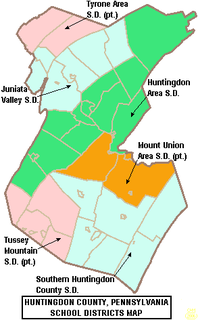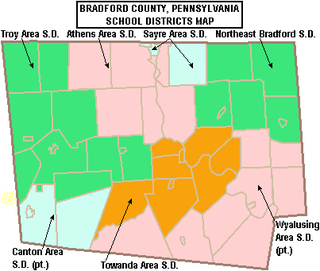
Proposition 13 is an amendment of the Constitution of California enacted during 1978, by means of the initiative process. The initiative was approved by California voters on June 6, 1978. It was upheld as constitutional by the United States Supreme Court in the case of Nordlinger v. Hahn, 505 U.S. 1 (1992). Proposition 13 is embodied in Article XIII A of the Constitution of the State of California.

The Conrad Weiser Area School District is located in western Berks County in the U.S. state of Pennsylvania. This district serves South Heidelberg Township, Heidelberg Township, North Heidelberg Township and Marion Township and the Boroughs of Wernersville, Robesonia and Womelsdorf. Eight properties in a housing development in West Cocalico in Lancaster County also attend the District's schools. The District encompasses approximately 100 square miles (260 km2). According to 2000 federal census data, it serves a resident population of 23,777. By 2010, the District's population declined to 19,303 people. In 2009, Conrad Weiser Area School District residents’ per capita income was $22,732, while the median family income was $57,488. In the Commonwealth, the median family income was $49,501 and the United States median family income was $49,445, in 2010. According to Conrad Weiser Area School District officials, in school year 2007-08 the Conrad Weiser Area School District provided basic educational services to 3,026 pupils through the employment of 237 teachers, 176 full-time and part-time support personnel, and 18 administrators. Conrad Weiser Area School District received more than $10.4 million in state funding in school year 2007-08.

The California state elections, 2006 took place on November 7, 2006. Necessary primary elections were held on June 6. Among the elections that took place were all the seats of the California's State Assembly, 20 seats of the State Senate, seven constitutional officers, and all the seats of the Board of Equalization. Votes on retention of two Supreme Court justices and various Courts of Appeal judges were also held. Five propositions were also up for approval.

California Proposition 87 was a proposition on the ballot for California voters for the November 7, 2006 general election, officially titled Alternative Energy. Research, Production, Incentives. Tax on California Oil Producers. It was rejected by the voters, 54.7% opposed to 45.3% in favor. This was highest-funded campaign on any state ballot and surpassing every campaign in the country in spending except the presidential contest.

The Pine-Richland School District is a mid-sized, suburban public school district serving northern Pittsburgh in Allegheny County, Pine. Pine-Richland School District encompasses approximately 31 square miles (80 km2) serving residents of Pine Township and of Richland Township.

Proposition 218 is an adopted initiative constitutional amendment which revolutionized local and regional government finance in California. Called the "Right to Vote on Taxes Act," it was sponsored by the Howard Jarvis Taxpayers Association as a constitutional follow-up to the landmark property tax reduction initiative constitutional amendment, Proposition 13, approved in 1978. Proposition 218 was approved by California voters during the November 5, 1996, statewide general election.

The 2007 Texas Constitutional Amendment Election took place 6 November 2007.

California Proposition 92 was Californian ballot proposition that voters rejected on February 5, 2008. It was a state initiative that would have amended Proposition 98, which set a mandate for the minimum level of funding each year for elementary and secondary schools and for the California Community Colleges.

The Southern Huntingdon County School District is a public rural school district based in the southeastern part of Huntingdon County, Pennsylvania in Three Springs, Pennsylvania. The school district includes all of Three Springs Borough, Cassville Borough, Orbisonia Borough, Rockhill Furnace Borough, Saltillo Borough, Shade Gap Borough, and including the townships of Cass Township, Clay Township, Cromwell Township, Dublin Township, Springfield Township and Tell Township. The district encompasses approximately 221 square miles. According to 2000 federal census data, it serves a resident population of 8,030. According to District officials, in school year 2007-08 the SHCSD provided basic educational services to 1,358 pupils through the employment of 113 teachers, 67 full-time and part-time support personnel, and 8 administrators.

The Wyalusing Area School District is a small enrollment, rural, public school district in northern Pennsylvania. It spans portions of two counties. Wyalusing Area School District encompasses approximately 273 square miles (710 km2). In southeastern Bradford County the District serves the Boroughs of New Albany and Wyalusing and Albany Township, Herrick Township, Overton Township, Stevens Township, Terry Township, Tuscarora Township, Wilmot Township and Wyalusing Township. In northwestern Wyoming County it serves the Borough of Laceyville and Braintrim Township and the northern and eastern portions of Windham Township. According to 2010 federal census data, it serves a resident population of 9,202. In 2009, the Wyalusing Area School District residents’ per capita income was $16,780, while the median family income was $38,279. In the Commonwealth, the median family income was $49,501 and the United States median family income was $49,445, in 2010. By 2013, the median household income in the United States rose to $52,100.

Proposition 1A was a defeated California ballot proposition that appeared on the May 19, 2009 special election ballot. It was a constitutional amendment that would have increased the annual contributions to the state's rainy day fund. The proposition was legislatively referred to voters by the State Legislature.

The Muhlenberg Area School District is a mid-sized, suburban, public school district serving parts of Berks County, Pennsylvania, United States. It encompasses the borough of Laureldale and the Muhlenberg Township. The district encompasses approximately 13 square miles (34 km2). Per the 2000 federal census data it served a resident population of 20,064. By 2010, the district's population declined to 23,562 people. In 2009, the district residents’ per capita income was $21,417, while the median family income was $51,356. In the Commonwealth, the median family income was $49,501 and the United States median family income was $49,445, in 2010.

The Jamestown Area School District is a diminutive, rural, public school district serving parts of Mercer County, Pennsylvania and Crawford County, Pennsylvania. It encompasses 61 square miles (160 km2) including the communities of Jamestown and Greene Township in Mercer County, and the municipalities of West Shenango Township and South Shenango Township in Crawford County. The enrollment, in 2011 was 580 pupils. This is among the 10% lowest enrollment in districts within the Commonwealth. According to 2000 federal census data, it serves a resident population of 4,377. By 2010, the district's population declined to 4,245 people. In 2009, the Jamestown Area School District residents' per capita income was $16,562, while the median family income was $40,690.

The Farrell Area School District is a diminutive, rural, public school district serving parts of Mercer County, Pennsylvania. Farrell Area School District encompasses approximately 3 square miles (7.8 km2) including: the communities of Farrell and Wheatland, both of which are adjacent to the much larger Sharon, Pennsylvania. According to 2000 federal census data, it serves a resident population of 6,798. By 2010, the district's population declined to 5,739 people. In 2009, Farrell Area School District residents' per capita income was $14,623, while the median family income was $29,821.

The California state elections was held on Election Day, November 6, 2012. On the ballot were eleven propositions, various parties' nominees for the United States presidency, the Class I Senator to the United States Senate, all of California's seats to the House of Representatives, all of the seats of the State Assembly, and all odd-numbered seats of the State Senate.

Proposition 29, the California Cancer Research Act, is a California ballot measure that was defeated by California voters at the statewide election on June 5, 2012.

Proposition 30, officially titled Temporary Taxes to Fund Education, is a California ballot measure that was decided by California voters at the statewide election on November 6, 2012. The initiative is a measure to increase taxes to prevent US$6 billion cuts to the education budget for California state schools. The measure was approved by California voters by a margin of 55 to 45 percent.

Proposition 55 is a California ballot proposition that passed on the November 8, 2016 ballot, regarding extending by twelve years the temporary personal income tax increases enacted in 2012 on earnings over $250,000, with revenues allocated to K–12 schools, California Community Colleges, and, in certain years, healthcare. Proposition 55 will raise tax revenue by between $4 billion and $9 billion a year. Half of funds will go to schools and community colleges, up to $2 billion a year would go to Medi-Cal, and up to $1.5 billion will be saved and applied to debt.

Proposition 13 was a failed California proposition on the March 3, 2020 ballot that would have authorized the issuance of $15 billion in bonds to finance capital improvements for public and charter schools statewide. The proposition would have also raised the borrowing limit for some school districts and eliminated school impact fees for multifamily housing near transit stations.

California Proposition 15 was a failed citizen-initiated proposition on the November 3, 2020 ballot. It would have provided $6.5 billion to $11.5 billion in new funding for public schools, community colleges, and local government services by creating a "split roll" system that increased taxes on large commercial properties by assessing them at market value, without changing property taxes for small business owners or residential properties for homeowners or renters. The measure failed by a small margin of about four percentage points.








